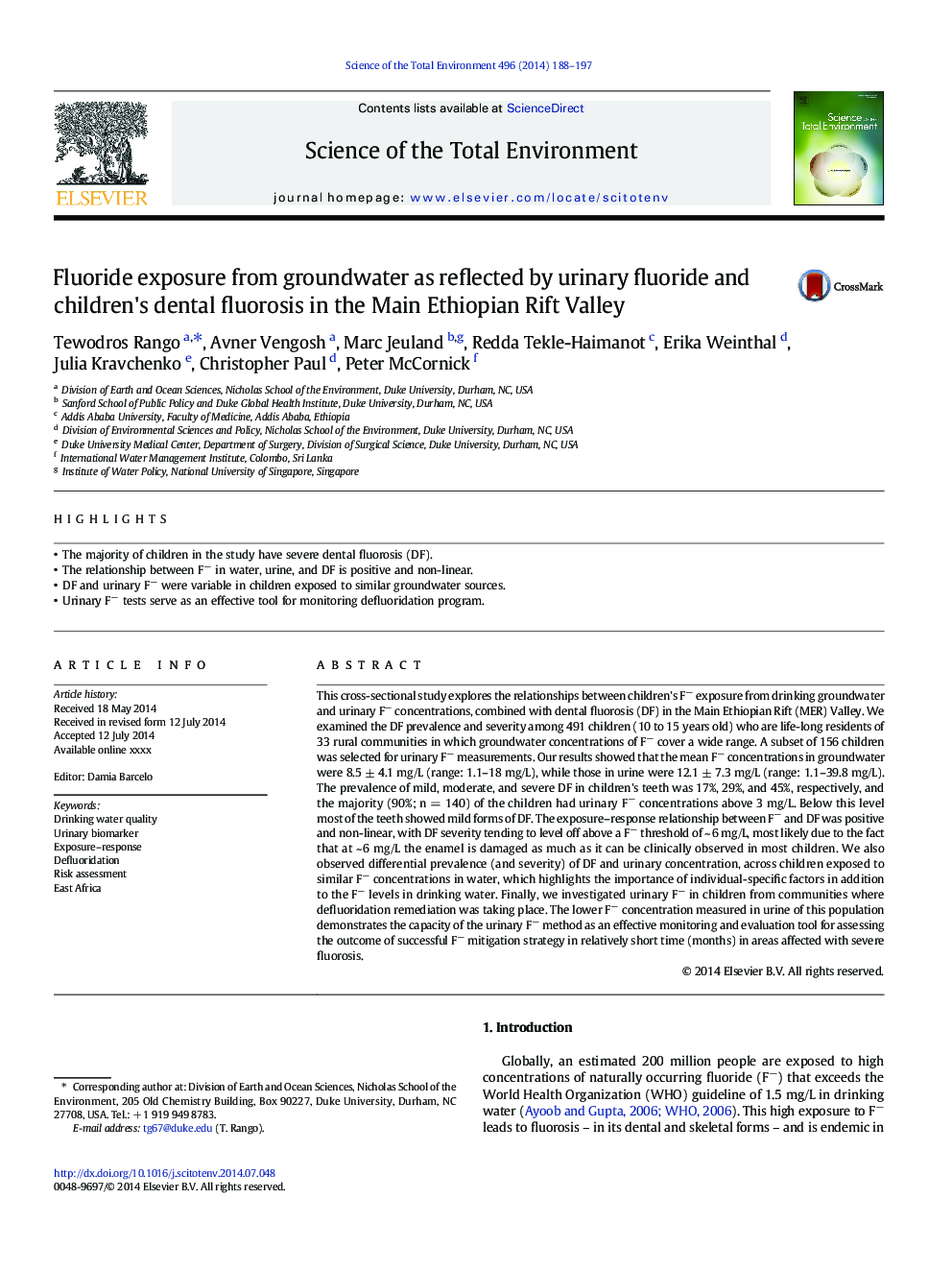| کد مقاله | کد نشریه | سال انتشار | مقاله انگلیسی | نسخه تمام متن |
|---|---|---|---|---|
| 6329428 | 1619776 | 2014 | 10 صفحه PDF | دانلود رایگان |
عنوان انگلیسی مقاله ISI
Fluoride exposure from groundwater as reflected by urinary fluoride and children's dental fluorosis in the Main Ethiopian Rift Valley
ترجمه فارسی عنوان
قرار گرفتن در معرض فلوراید از آب های زیرزمینی به علت فلوراید ادرار و فلوروزیس دندان کودک در ریف اتیوپی
دانلود مقاله + سفارش ترجمه
دانلود مقاله ISI انگلیسی
رایگان برای ایرانیان
کلمات کلیدی
کیفیت آب آشامیدنی، بیومارکر ادرار، در معرض قرار گرفتن در معرض، ضدعفونی کردن، ارزیابی ریسک، آفریقای شرقی،
موضوعات مرتبط
علوم زیستی و بیوفناوری
علوم محیط زیست
شیمی زیست محیطی
چکیده انگلیسی
This cross-sectional study explores the relationships between children's Fâ exposure from drinking groundwater and urinary Fâ concentrations, combined with dental fluorosis (DF) in the Main Ethiopian Rift (MER) Valley. We examined the DF prevalence and severity among 491 children (10 to 15 years old) who are life-long residents of 33 rural communities in which groundwater concentrations of Fâ cover a wide range. A subset of 156 children was selected for urinary Fâ measurements. Our results showed that the mean Fâ concentrations in groundwater were 8.5 ± 4.1 mg/L (range: 1.1-18 mg/L), while those in urine were 12.1 ± 7.3 mg/L (range: 1.1-39.8 mg/L). The prevalence of mild, moderate, and severe DF in children's teeth was 17%, 29%, and 45%, respectively, and the majority (90%; n = 140) of the children had urinary Fâ concentrations above 3 mg/L. Below this level most of the teeth showed mild forms of DF. The exposure-response relationship between Fâ and DF was positive and non-linear, with DF severity tending to level off above a Fâ threshold of ~ 6 mg/L, most likely due to the fact that at ~ 6 mg/L the enamel is damaged as much as it can be clinically observed in most children. We also observed differential prevalence (and severity) of DF and urinary concentration, across children exposed to similar Fâ concentrations in water, which highlights the importance of individual-specific factors in addition to the Fâ levels in drinking water. Finally, we investigated urinary Fâ in children from communities where defluoridation remediation was taking place. The lower Fâ concentration measured in urine of this population demonstrates the capacity of the urinary Fâ method as an effective monitoring and evaluation tool for assessing the outcome of successful Fâ mitigation strategy in relatively short time (months) in areas affected with severe fluorosis.
ناشر
Database: Elsevier - ScienceDirect (ساینس دایرکت)
Journal: Science of The Total Environment - Volume 496, 15 October 2014, Pages 188-197
Journal: Science of The Total Environment - Volume 496, 15 October 2014, Pages 188-197
نویسندگان
Tewodros Rango, Avner Vengosh, Marc Jeuland, Redda Tekle-Haimanot, Erika Weinthal, Julia Kravchenko, Christopher Paul, Peter McCornick,
